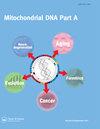DNA barcoding of fruit flies (Diptera: Tephritidae) in Thailand: ambiguity, misidentification and cryptic diversity
IF 0.6
4区 生物学
Q4 GENETICS & HEREDITY
引用次数: 8
Abstract
Abstract Fruit flies (Diptera: Tephritidae) are significant insect pests of many commercially important fruits and vegetables. Therefore, rapid and accurate species identification methods are required for the regulation, management and quarantine of these pests. In this study, we examined the efficiency of mitochondrial cytochrome c oxidase I sequences for species identification of fruit flies in Thailand. Data analyses based on 42 fruit fly taxa revealed moderate performance of this genetic marker. There were 14 taxa that have no barcode gap and thus could not be identified unambiguously to species by this methodology. Taxonomic uncertainty, inadequate variation of the marker and misidentifications of specimens deposited in the public database are the most likely factors explaining unsuccessful identification. DNA barcodes also revealed cryptic diversity in five taxa (Bactrocera caudata, B. tuberculata, B. infesta, Zeugodacus isolatus, Carpomya vesuviana). These species require further taxonomic investigation of if they are different cryptic taxa or are indications of geographic structuring of within single species.泰国果蝇(双翅目:蝗科)的DNA条形码:歧义、误认和隐型多样性
摘要果蝇(双翅目:蝗科)是许多具有重要商业价值的水果和蔬菜的重要害虫。因此,需要快速、准确的物种鉴定方法来规范、管理和检疫这些害虫。在这项研究中,我们检测了线粒体细胞色素c氧化酶I序列在泰国果蝇物种鉴定中的效率。基于42个果蝇类群的数据分析表明,该遗传标记的表现中等。有14个类群没有条形码间隙,因此不能用这种方法明确地识别为物种。分类上的不确定性、标记的不充分变异和公共数据库中标本的错误鉴定是导致鉴定失败的最可能因素。DNA条形码还显示了5个分类群(尾小实蝇、结核小实蝇、感染小实蝇、隔离小实蝇和维苏威Carpomya vesuviana)的隐性多样性。这些物种是否属于不同的隐蔽分类群,或者是单一物种内地理结构的标志,需要进一步的分类学研究。
本文章由计算机程序翻译,如有差异,请以英文原文为准。
求助全文
约1分钟内获得全文
求助全文
来源期刊

Mitochondrial Dna Part a
Biochemistry, Genetics and Molecular Biology-Genetics
CiteScore
3.00
自引率
0.00%
发文量
6
期刊介绍:
Mitochondrial DNA Part A publishes original high-quality manuscripts on physical, chemical, and biochemical aspects of mtDNA and proteins involved in mtDNA metabolism, and/or interactions. Manuscripts on cytosolic and extracellular mtDNA, and on dysfunction caused by alterations in mtDNA integrity as well as methodological papers detailing novel approaches for mtDNA manipulation in vitro and in vivo are welcome. Descriptive papers on DNA sequences from mitochondrial genomes, and also analytical papers in the areas of population genetics, phylogenetics and human evolution that use mitochondrial DNA as a source of evidence for studies will be considered for publication. The Journal also considers manuscripts that examine population genetic and systematic theory that specifically address the use of mitochondrial DNA sequences, as well as papers that discuss the utility of mitochondrial DNA information in medical studies and in human evolutionary biology.
 求助内容:
求助内容: 应助结果提醒方式:
应助结果提醒方式:


